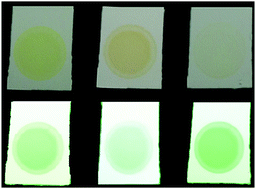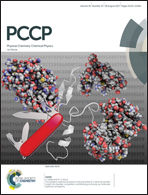Tunable AIEE fluorescence constructed from a triphenylamine luminogen containing quinoline – application in a reversible and tunable pH sensor†
Abstract
Herein, tunable emissions in aggregation processes of triphenylamine derivatives (TPAQs) and their protonated cations, as well as protonated processes have been described. In this study, three triphenylamine-based compounds (TPAQs) were synthesized and their optical properties were investigated. Initially, the TPAQs displayed aggregation-induced emission enhancement (AIEE) properties via the restricted intramolecular charge transfer (ICT) state. Interestingly, the single-branched fluorophore (STPAQ) and its protonated cation emitted different color fluorescence in the solution and aggregation state. They emitted green fluorescence, which originated from the intramolecular charge transfer (ICT) state in a strong polar solvent, but the fluorescence bands turned blue, which was attributed to the LE state in the aggregated state. However, the cations of triple-branched fluorophores (TTPAQs) exhibited an inverse tunable emission process from bluish violet fluorescence of the LE state in a weak polar solvent (e.g., THF) to green fluorescence of the ICT state in the aggregated state. In a THF/water mixture solution (fw = 10%), the STPAQ could switch its emission between blue and green in the pH range of 10.0–0.5. This phenomenon enabled STPAQ to serve as a fluorescent pH sensor in solution. In the powder state, double-branched fluorophores (DTPAQs) could be used as a fluorescent sensor for the detection of acidic and basic organic vapors in the solid state.



 Please wait while we load your content...
Please wait while we load your content...